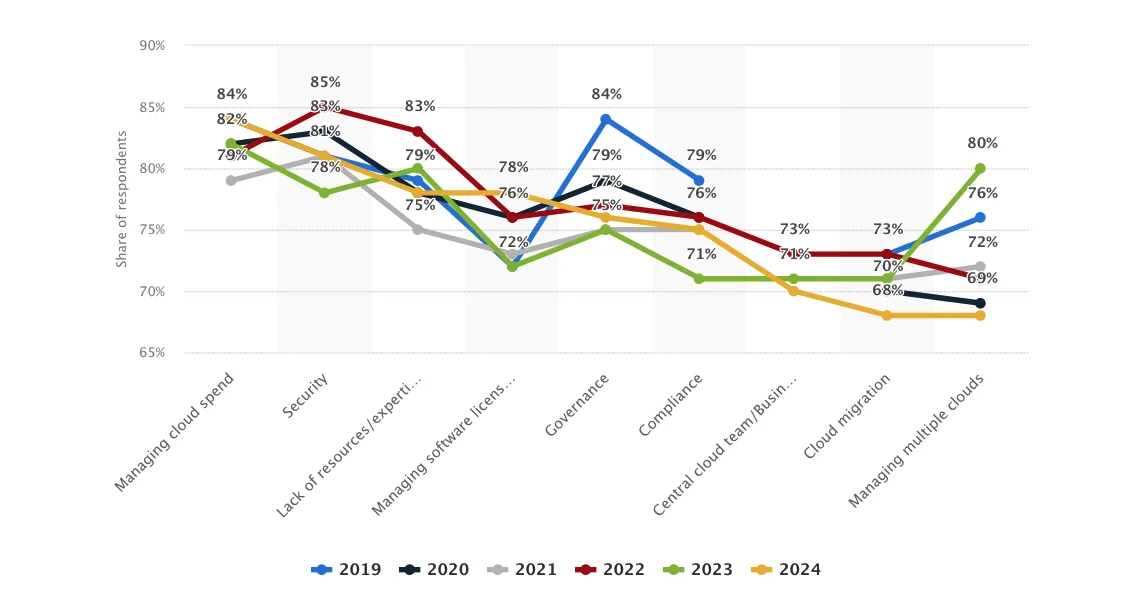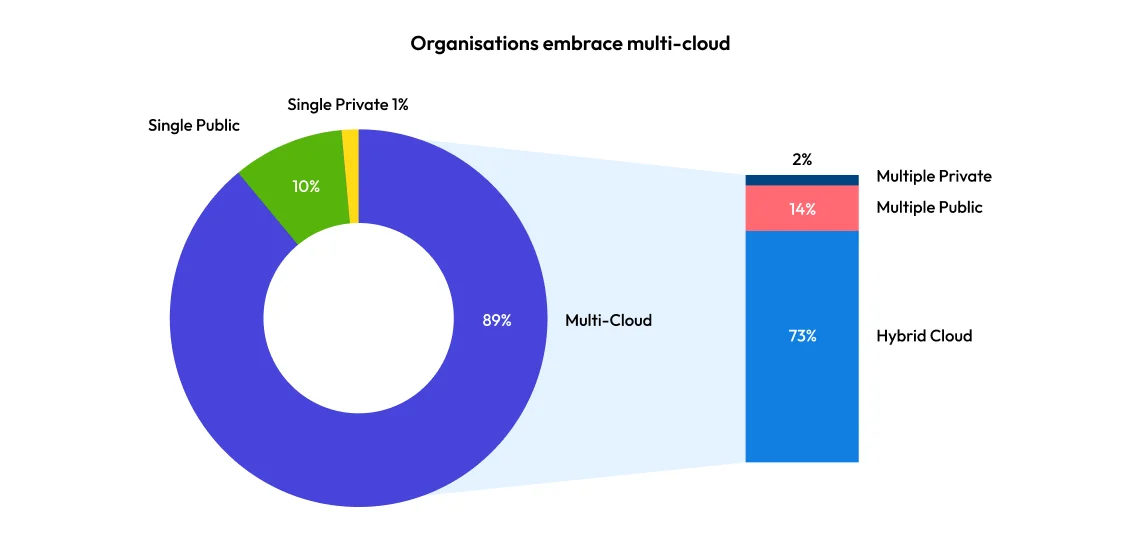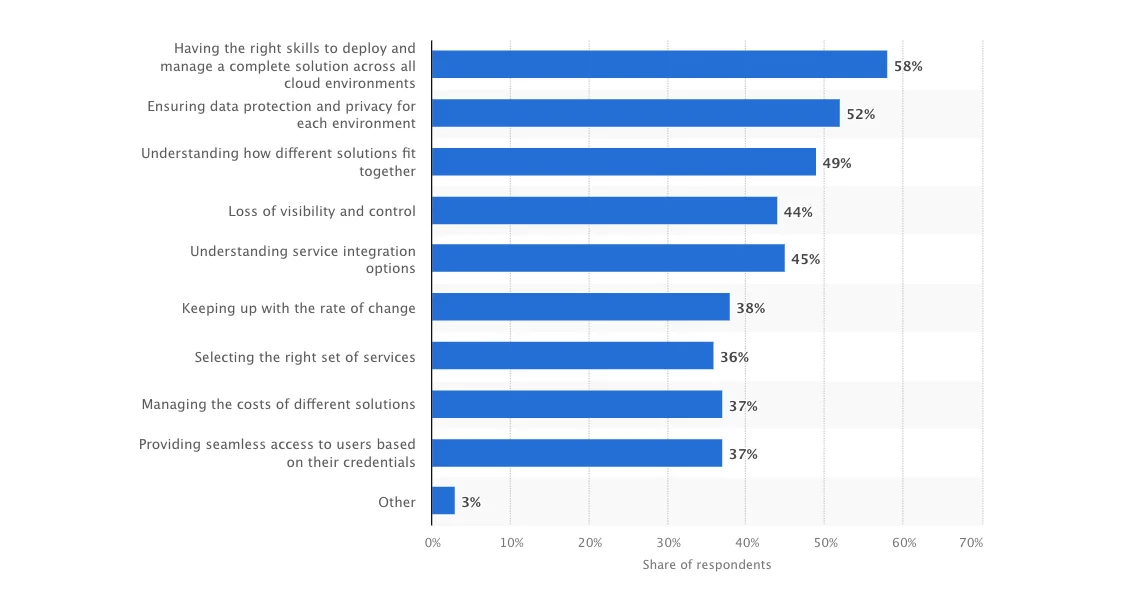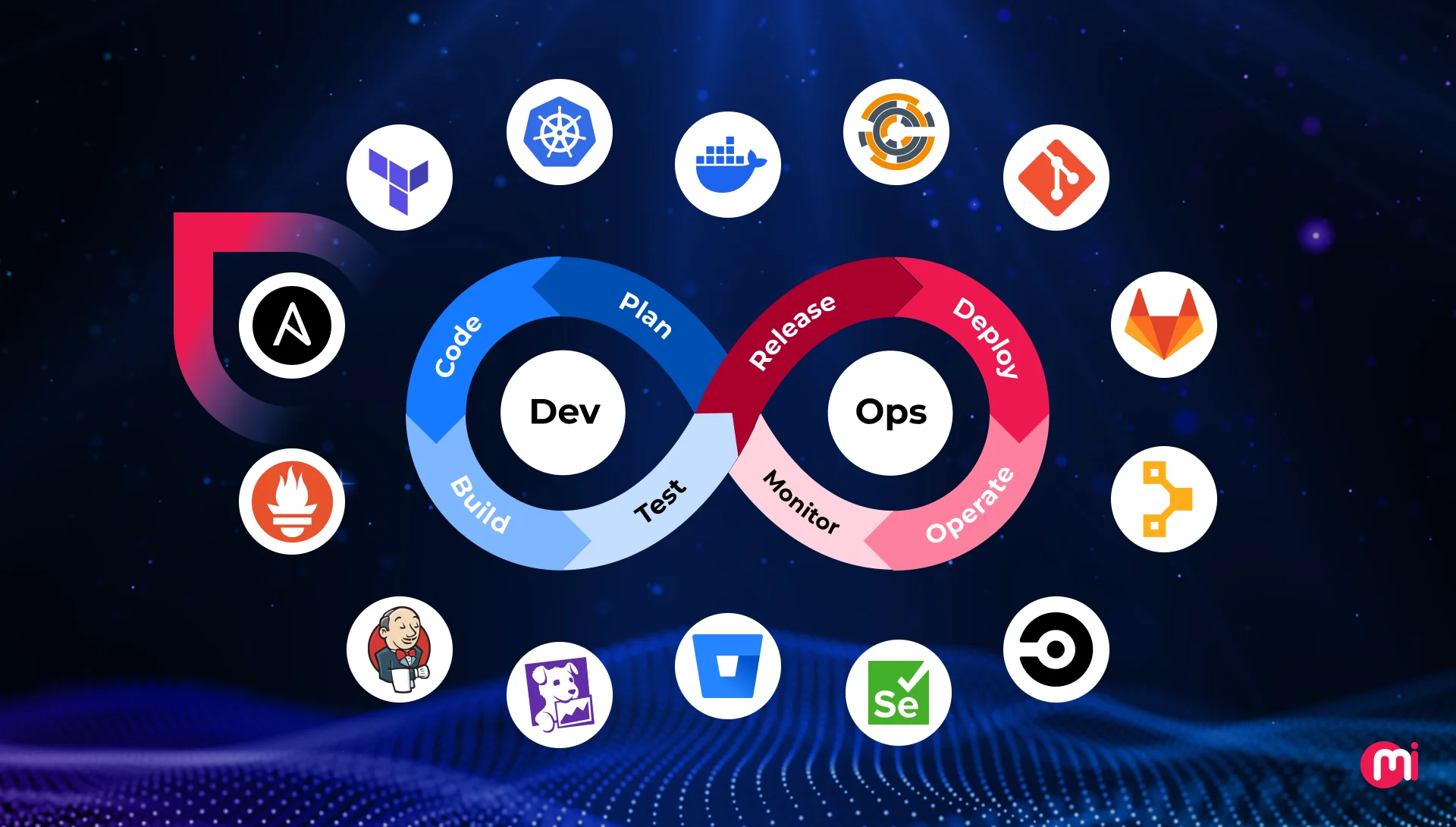Top 10 Cloud Computing Challenges and Their Best Solutions
- DevOps
- February 24, 2025
Cloud computing is becoming indispensable, leading many businesses to focus on adopting cloud technology in some or all aspects of their business operations and services. However, cloud adoption can be challenging. This blog lists some of the most common challenges of cloud computing that businesses face and offers solutions to overcome them.
Cloud computing is poised to become a necessity for businesses within the next decade, with organizations across industries aggressively investing in cloud technology. End-user spending on public cloud services is a testament to this trend. According to Gartner, spending on public cloud services reached $679 billion in 2024 and is projected to exceed $1 trillion by 2027.
As businesses increasingly rely on cloud computing to streamline operations, scale efficiently, and enhance data accessibility, it becomes crucial to understand the challenges associated with cloud adoption. A well-informed approach to cloud computing can help businesses mitigate risks and maximize the benefits of this transformative technology.
Before diving into the challenges, let’s briefly understand this technology. Cloud computing involves storing, accessing, and managing large amounts of data and software applications online. In cloud computing technology, firewall networks protect the data.
This technology helps you install software and its data in data centers globally, which enables you to utilize the software app without using the hard drive of your PC. Many people use cloud technology in their daily lives. Making a document online or using an online email service is a general example of cloud technology.
Several types of cloud computing are present in the IT industry, such as PaaS (Platform as a Service), SaaS (Software as a Service), and IaaS (Infrastructure as a Service). In today’s world, cloud technology helps in business development and brings amazing on time.
According to Flexera 2025 State of the Cloud Report, 60% of all organizations use MSPs (Managed services providers) in some capacity for managing public cloud.

Both success and failure are parts of businesses and they have a little gap in between. Every technology has its pros and cons. If you adopt cloud computing for business, you can certainly take your company to new heights.
Also, your business can experience troubles if you fail to have an effective adoption strategy. But what are the challenges that you may encounter in the adoption process? Don’t think much, here are the challenges of cloud computing that you may face and solutions that you can implement to overcome or alleviate them.
10 Biggest Cloud Computing Challenges with Solutions
Despite being the major strength of some businesses, cloud computing also has some issues. And in some rare circumstances, this can cause some serious problems as well.
In the below survey by Statista, where their team surveyed global technical executives, managers, and practitioners of cloud technologies to indicate the major challenges that they face when using cloud technology.

These issues or challenges are real-life nightmares of cloud computing. Let’s talk about some of them briefly!
1. Security of Data
Several cloud security incidents occurring globally are evident and indicate where companies can go wrong in terms of securing their data on the cloud, especially on third-party servers. According to the Annual SaaS Security Survey Report, around 55% of organizations have reported cloud security-related incidents in the last two years.
These incidents vary from data breaches to data loss, and more. The lack of visibility and control over data makes it difficult for organizations to manage the security of the data effectively. Furthermore, this issue is worsened if the organization fails to implement regular and comprehensive backup strategies, making them unable to recover the data.
However, according to cloud computing statistics, approximately 91% of respondents acknowledge the importance of public cloud platforms in disaster recovery strategies.
In addition, one of the most critical challenges of cloud computing that organizations face is complying with relevant data privacy regulations like GDPR, HIPAA, and more. Failing to do so can lead to hefty fines and reputational damage.
Solution
Here is how you can overcome cloud data security-related challenges:
- Instead of default configurations, configure your security settings according to your needs
- Implement identity and access management practices like multi-factor authentication (MFA) and role-based access controls (RBAC)
- Have automated backup solutions, disaster recovery plans, and versioning in place.
- Use tools designed to monitor and enforce compliance with regulations like GDPR, HIPAA, and others
- Conduct regular audits and assessments to ensure compliance
2. Lack of Expertise
In the white paper published by SoftwareONE, there is a mention of findings from the SoftwareONE Cloud Skills Report, where the company gathered opinions from 500 IT decision-makers from the UK, Benelux, North America, and Australia on cloud skill shortages. The findings highlight that 95% of respondents reported a lack of cloud skills, which significantly impacted their organizations.
Although many IT employees and employers are taking different initiatives to improve their expertise in cloud computing, employers still find it challenging to find employees or certified individuals with the expertise that they require.
Solution
Here is what organizations or enterprises can do to overcome the skill gap:
- Invest in employee upskilling and reskilling
- Hire dedicated cloud-skilled experts
- Foster a continuous learning culture
- Implement cloud management platforms and train employees to use them
3. Governance/Control over IT Services
Due to the shared responsibility model between the organization and the cloud service provider (CSP), organizations often experience a lack of visibility into their cloud resources. This limited visibility can hinder their ability to assess the security processes and data handling practices implemented by the CSP.
Other governance challenges include vendor lock-in, shadow IT (employees using unauthorized cloud services outside established IT procedures), and integration with on-premises infrastructure.
While eliminating governance and control challenges in cloud computing may not be possible due to the shared responsibility model.
Solution
here are some solutions you can implement to reduce the risks and their impact:
- To get detailed insights(and thereby improve transparency), implement cloud management and monitoring tools
- Develop clear policies and procedures for cloud service approval to minimize the use of unauthorized cloud services
- Avoid vendor-specific configurations whenever possible
- Use automated security and compliance tools
4. Cloud Cost Management
Uncontrolled cloud spending in cloud computing can arise from various factors. A major reason is limited visibility and cost transparency. This makes it difficult for organizations to track and analyze cloud resource utilization.
In certain scenarios, especially when companies over-provision resources, there’s a possibility of unmanaged cloud sprawl going undetected. This sprawl can take the form of shadow IT (unauthorized cloud services) or even zombie resources (idle instances).
Last but not least, hidden charges and complex billing structures offered by cloud service providers can also lead to unexpected costs and complicate cloud cost management.
Solution
Here are some key solutions to tackle these cost management challenges in cloud computing:
- Leverage cloud cost management tools that provide detailed insights into every aspect of your company’s cloud spending.
- Establish budgets for cloud spending and configure alerts to notify you when expenditures approach or exceed predefined thresholds.
- Ensure you are aware of all hidden costs, such as cloud data egress fees, support costs, regional pricing, termination fees, etc.
- Implement auto-scaling to dynamically adjust resources based on demand.
- Implement dashboards to provide organization-wide visibility into cloud usage and costs.
- Conduct regular audits to identify and eliminate idle resources.
- Consider reserved instances or committed use discounts for workloads with predictable usage pattern.
- Explore multi-cloud deployments to leverage competitive pricing and potentially avoid vendor lock-in.
5. Managing Multi-Cloud Environments
Multi-cloud is the new normal! The following statistics provide evidence of this trend.
According to Oracle’s second annual multi-cloud survey, 98% of surveyed enterprises are either already using multi-cloud or planning to adopt it.
As per the Flexera 2024 State of the Cloud Report, nearly 89% of the companies are following a multi-cloud strategy and 73% already have their hybrid cloud tactic that is combined with the public and private cloud.

While organizations are adopting the multi-cloud approach, it comes with its own set of challenges of cloud computing. These include difficulties in managing digital solutions across multiple cloud environments, as well as a lack of skills or proficiency exacerbating this challenge. Another major hurdle is ensuring data privacy and protection, alongside establishing seamless collaboration and connectivity among these solutions.
The graph below by Statista highlights additional challenges faced by companies.

Solution
Here are some key solutions that would empower your organization to efficiently manage multi-cloud environments:
- Adopt cloud management platforms (CMPs) or cloud orchestration tools (e.g., Kubernetes, Terraform)
- Ensure the cloud services you choose support interoperable APIs and standards for seamless integration
- Implement a unified cloud governance framework
- Consider automating routine tasks like provisioning and scaling to improve efficiency.
- Hire experts with experience in managing multi-cloud environments
Also Read: Multi Cloud vs Hybrid Cloud: Which One To Choose?
6. Maintaining Compliance
Another critical aspect for every business is ensuring compliance with industry-specific regulations and security standards. Each business, based on its industry and geographical location, faces specific compliance obligations.
For instance, healthcare organizations must ensure that cloud services meet HIPAA requirements, while fintech startups using cloud solutions must adhere to PCI DSS (Payment Card Industry Data Security Standard) and GDPR (General Data Protection Regulation). Educational institutions in the USA must comply with FERPA (Family Educational Rights and Privacy Act).
While it is the responsibility of the Cloud Service Provider (CSP) to ensure compliance, organizations often struggle due to lack of visibility.
Learn more: Cloud Computing in Education: Shaping University EdTech Platforms Through Unified Approach
Solution
Here are some solutions that organizations can consider to tackle compliance challenges:
- Develop and implement a comprehensive compliance strategy.
- Select cloud providers with strong compliance certifications (e.g., SOC 2, ISO 27001) and transparent compliance practices.
- Implement data encryption at rest and in transit.
- Conduct regular audits and assessments of cloud infrastructure.
- Use Cloud Security Posture Management (CSPM) tools.
7. Cloud Data Migration
One of the major aspects of migrating to a cloud-native app involves transferring a huge amount of data to the cloud infrastructure. This data is sensitive, has a complex structure, large volume, dependencies, varied types/formats, and more. Migrating this data is an extensive and time-consuming process.
It involves challenges such as data security, compliance, downtime, disruption of business processes, data integrity, compatibility with the cloud environment, seamless integration with the apps and systems, data governance, latency, and more.
Given the complexity and risks involved in data migration, a detailed cloud migration checklist is crucial for effective planning. It helps address key challenges like data security, compliance, and system compatibility, ensuring a smoother and more controlled migration process.
Solution
Here is how you can ensure to overcome all the hurdles that come with seamless data migrations:
- Conduct a comprehensive assessment of data pre-migration.
- Implement robust security measures such as encryption and access controls.
- Opt for incremental migration to maintain parallel operations.
- Define a prioritized migration order based on data criticality.
- Cleanse and standardize data formats to ensure accuracy, consistency, and compatibility.
- Utilize specialized tools that automate the process.
To understand the cloud migration challenges in detail, explore our blog on cloud migration – benefits, challenges, and how to avoid them.
8. Vendor Lock-In
At present, a few topmost cloud service providers, for instance, Google Cloud Platform, Microsoft Azure, Amazon Web Services, and IBM Cloud, are ruling over the public cloud market.
Given the limited portability and interoperability caused by proprietary data formats or vendor-specific APIs, businesses face challenges in migrating, transferring, or integrating into another cloud provider’s environment or API. This reliance on specific cloud providers is exacerbated by the uniqueness of proprietary services and APIs.
When integrating these data, apps, or digital assets into a new environment, apart from compatibility, businesses may encounter complexities in data extraction, transformation, and ensuring data security and compliance.
Dependence or lock-in to a specific environment can lead to substantial costs if the vendor discontinues a service or significantly increases prices.
Solution
Here is how you can ensure that there is a lesser possibility of vendor lock-in:
- Use open standards and technologies to ensure greater portability
- Consider a phased migration strategy by using open-source data migration tools
- Employ middleware solutions and APIs that facilitate seamless integration across different cloud platforms
- Implement a multi-cloud strategy to avoid dependency on a single vendor
9. Integration with Legacy or On-premise Systems
Apart from transferring data to the cloud environment, cloud computing involves integrating existing or on-premise infrastructure with the cloud infrastructure. When doing so, the challenges in cloud computing that businesses often face include technical incompatibility, security concerns, performance issues, latency issues, compliance maintenance, and more.
Solution
Here are some strategies that can help organizations ensure seamless integration with legacy systems:
- Use middleware solutions and APIs to facilitate seamless integration.
- Employ data transformation tools to convert data formats and protocols between legacy systems and cloud platforms.
- Optimize network configurations and utilize caching mechanisms.
- Implement load balancing to enhance performance across integrated systems.
- Leverage a combination of methods such as APIs, data warehousing, or event-driven architectures.
10. Network and Connectivity Issues
One of the critical facets that keeps the cloud-based operations of the business running is network and connectivity.
This network and connectivity can be affected by issues such as slow network speeds, limited bandwidth, cyber threats, network outages, difficulty in scaling network resources, geo-restrictions, delays in data transmission, congested network infrastructure, and more.
Solution
Here is how you can ensure efficient network and seamless connectivity:
- Evaluate bandwidth usage and consider upgrading internet plans to ensure sufficient capacity.
- Deploy content delivery networks (CDNs) and edge computing to reduce latency.
- Implement network optimization techniques such as traffic shaping and prioritization.
- Enforce robust network security measures including firewalls, IDS, and encryption protocols.
- Consider redundant network paths and failover mechanisms.
- Utilize auto-scaling capabilities and software-defined networking (SDN).

Overcome Challenges of Cloud Computing with MindInventory’s Expertise
We are experts in providing end-to-end cloud engineering services. Whether you are looking to move your data to the cloud, improve cloud application performance, or scale your infrastructure, MindInventory offers comprehensive cloud solutions to empower your business for long-term success.
Our range of solutions includes cloud integration, cloud-native app development, cloud migration, serverless computing, and more. We have a team of seasoned developers experienced in tackling the challenges of cloud computing, with expertise in DevOps, knowledge of best practices, industry-leading tools, and more. Our experts are skilled enough to guide you through the complexities of cloud computing, helping you develop cloud solutions designed to optimize performance, cloud security, and scalability.
In one of the projects from our cloud computing portfolio, our team successfully implemented an Azure cloud server to enable the client’s web platform – virtual machine advisor, Octopus, to facilitate virtual machines. We not only set up the Azure virtual network but also migrated the workloads, conducted testing, and optimized configurations to achieve the desired cloud implementation results.
In another project, which involved a tactical asset allocation robo-advising app, our team overcame the challenge of making the app efficient enough to support a growing user base and ensure business scalability. For this, we implemented a cloud microservices architecture to deliver robust performance and adaptability.
At MindInventory, we understand that every business has unique cloud computing needs. Whether you’re just starting your cloud journey or looking to enhance your current infrastructure, our team is here to guide you every step of the way without you having to worry about the cloud computing challenges.
Let us help you harness the power of cloud computing technology together to unlock new opportunities, reduce costs, and drive business growth. Contact our team today to discuss how our scalable and efficient cloud solutions can transform your business.
FAQs on Challenges of Cloud Computing
Some of the significant challenges of cloud computing include data privacy, data security, performance issues, interoperability, high dependence on the network, lack of reliability, high unavailability of cloud services, vendor lock-in, the complexity of multi-cloud environments, and more.
Some of the common cloud security risks associated with cloud computing include data loss, data breaches, unauthorized access, cyberattacks, denial-of-service attacks, API insecurities, regulatory and compliance risks, and more.
SLA is an abbreviation for Service Level Agreements in cloud computing, which refers to a contractual agreement between a cloud service provider (CSP) and a customer. This agreement includes the level of service that will be offered by the CSP, specific KPIs, a set of deliverables, and more.
The biggest business challenges that can be addressed with cloud solutions include scalability, customer experience, security, internal data thefts, challenges with legacy data centers, time to market, and more.













